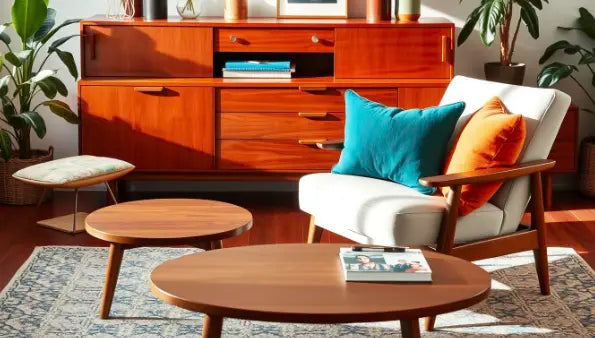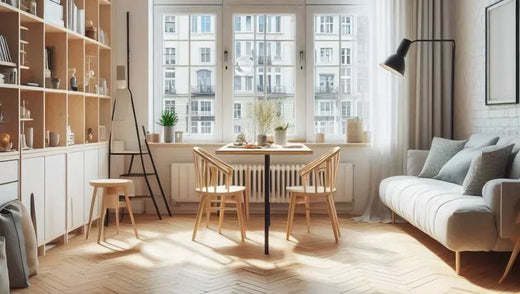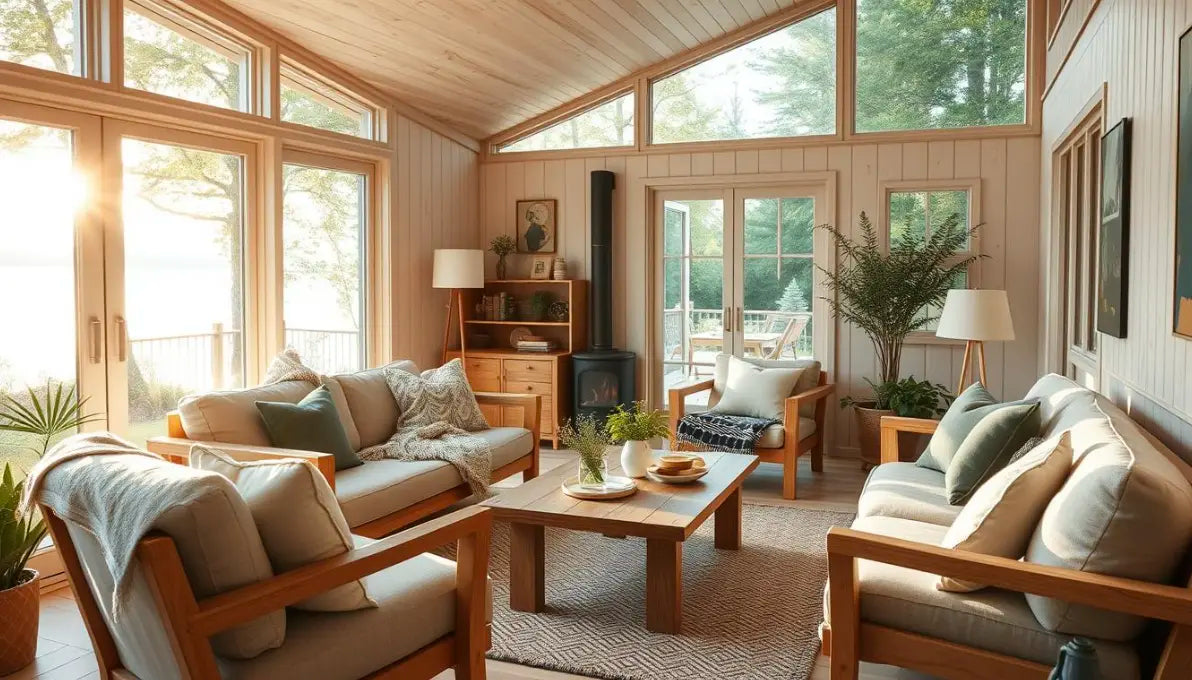Wondering how to refresh classic Scandinavian furniture from the 60s? Renovating vintage furniture has become not only a fashionable trend, but also a way to give new life to our interior designs.
Classic furniture designs from this era are not only aesthetically pleasing, but also functional. Today, we will take a look at why it is worth renovating furniture to transform it into stylish decorative elements in our homes.
We will present the benefits of this process, from both an ecological and visual perspective.

Renovated furniture not only saves resources, but also introduces a unique character to the interior, combining vintage with modern solutions. See how furniture designs from the 60s can become a key element of your lifestyle.
The history of retro style in Scandinavian furniture
The retro style, which gained recognition in the 1960s, is characterized by bold forms and functionality.
During this period, Scandinavian furniture became a symbol of quality and simplicity, attracting the attention of design lovers around the world. Designs such as the iconic egg chair stand out for their elegance and functionality, and their popularity continues to this day.
The history of retro style in Scandinavian furniture has undoubtedly influenced the shape of contemporary interiors. Furniture from the 60s often uses natural materials, bright colors and minimalist design, which fits in with current interior design trends. This approach makes Scandinavian furniture such as desks or shelves timeless, and their renovation is becoming fashionable today.
Designs from the 60s that combine elements of functionality with aesthetics, creating spaces that attract attention. The retro style inspires not only designers, but also DIY enthusiasts who want to introduce a bit of history and unique character to their interiors.
The patterns and soft throws that characterize this style still have a lot to offer, in both traditional and modern arrangements.
Key features of 1960s Scandinavian style
The style of the 60s in furniture is characterized by simplicity and functionality. The features of the Scandinavian style are manifested in minimalist forms and the use of natural materials such as oak and walnut wood. Scandinavian furniture from this period combines elegance and practicality, which makes it timeless. In arrangements inspired by the features of the Scandinavian style, colors play a key role. Delicate shades of pastels, whites and subdued grays often appear, which introduces harmony to the interior. The functionality of the furniture goes hand in hand with its aesthetics, which makes it ideal for various living spaces.
Contemporary inspirations related to the style of the 60s show how this heritage still influences our approach to interior design. Features of the Scandinavian style , such as open spaces and transparency, are gaining increasing recognition, especially in the context of ecological and local materials. Design allows for the creation of unique atmospheres that combine modernity with tradition, which attracts lovers of original solutions in home decoration.
How to refresh classic Scandinavian furniture.
Renovating classic Scandinavian furniture is not only a chance to restore its former glory, but also an expression of individuality in interior design.
To effectively refresh classic Scandinavian furniture , it is worth learning proven methods of renovating wooden furniture and choosing the right paints and varnishes that will emphasize their natural beauty.
Ways to renovate wooden furniture
Renovating wooden furniture starts with a thorough cleaning of its surface. Sanding can be used to remove old coatings and prepare the wood for further work. Staining will give the wood a deep color that will emphasize its natural grain. Then it is worth reaching for furniture paints and varnishes , choosing products adapted to the Scandinavian style, usually focusing on light colors.
Choosing the right paints and varnishes
The choice of paints and varnishes for furniture plays a key role in the final effect of renovation. The right preparations should highlight the texture of the wood and give it a modern look.
It is often worth reaching for ecological paints, which are not only environmentally friendly but also safe for health. A well-chosen varnish will increase the durability of furniture and also facilitate its subsequent cleaning.

Retro style colors
Retro colors are of great importance in creating Scandinavian-style interiors. In the 60s, pastel shades dominated, introducing warmth and coziness. Characteristic colors included delicate shades of pink, mint and blue, which perfectly matched vintage furniture. Intense accents, such as deep reds or greens, introduced dynamics to the arrangement, while emphasizing the minimalist aesthetic of Scandinavian style.
Interiors with retro colors often gain in quality thanks to the right choice of colors. Bright walls in neutral shades, such as white or light gray, are a perfect background for vintage furniture. This combination makes the space optically larger and more friendly. Scandinavian style focuses on natural materials, which means that colors should harmonize with wood and fabrics, creating a coherent atmosphere.
By combining subdued colours with intense accents, you can create a unique atmosphere. Well-chosen colours enliven interiors and attract attention, giving character to Scandinavian furniture.
The key to success is the ability to balance between different shades and their bold combination in the context of vintage furniture. The retro colors of the 60s still inspire contemporary arrangements, and its subtlety delights and adds a unique charm to every room.
Materials typical of the 1960s
In the Scandinavian style of the 1960s, materials that combined aesthetics with functionality were key. It is worth taking a closer look not only at teak wood , but also at natural fabrics, which significantly influenced the look and approach to interior design during this period. These materials from the 1960s help to achieve harmony and coziness, and their presence in today's interiors is evidence of the continued popularity of Scandinavian style.
Teak Wood and Its Alternatives
Teak wood , known for its durability and aesthetics, dominated furniture of this period. Its natural properties make it resistant to water and temperature changes. Contemporary designs often use alternatives such as oak or pine, which also offer exceptional aesthetic values. Choosing the right materials from the 60s influences the character of the interior, emphasizing its minimalism and functionality.
Natural fabrics in interior design
Natural fabrics , such as linen or cotton, were commonly used in interior textiles from the 1960s. Their pleasant to the touch structure and ecological properties fit perfectly into the Scandinavian aesthetic. Contemporary arrangements still use fabrics of natural origin, which significantly increases the comfort and aesthetics of interiors. The use of such materials from the 1960s reflects current trends and care for the environment.
Vintage furniture worth renovating
Vintage furniture from the 1960s has a unique aesthetic and historical value, making it a great candidate for restoration. Chairs, tables, and beds from this period are often made of solid wood, which means they can be passed down from generation to generation.
Furniture renovation is not only a way to preserve its original shine, but also a method to introduce Scandinavian designs into modern interiors. In the renovation process, it is important to focus on the entire piece of furniture, not just the fronts. Restoring the shine of wooden items requires knowledge about the type of wood and the coatings used. It is also extremely important to use the right tools, such as sandpaper, grinders or paints for wooden furniture. Work is best done in well-ventilated areas, which will ensure comfort and safety.
You can't forget about the details that give furniture character. Replacing fittings and handles can have a spectacular effect on the final look of the renovated piece of furniture. Old wooden furniture can be renovated in various styles, from rustic to classic, which gives a lot of room for creativity for the owners.
It is also worth remembering that furniture renovation is a costly investment that contributes to recycling and caring for the environment. Each renovated piece is a reflection of the love for beauty and design. Preserving vintage furniture not only enriches our interiors, but also allows us to draw from their history in everyday life.





